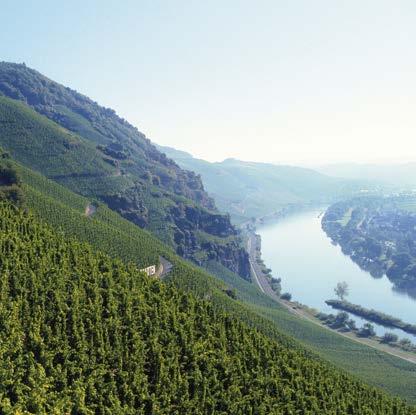
11 minute read
Mosel
THE RIESLING SPECIALISTS
The wine-growing area along the Mosel, Saar and Ruwer rivers is regarded as Germany’s oldest wine region. The Romans introduced viticulture on a large scale; the monks and nuns of the medieval monasteries furthered its development on steep hillsides. Countless finds, including several press houses from Roman times, bear witness to a great viticultural tradition. Today, half of the vineyard area is on steep slopes or terraces with an angle of inclination of more than 30 degrees. Some 5,000 wine-growers in 125 wine villages cultivate more than 8,800 ha (22,000 acres) of vines along the Mosel between Perl and Koblenz, the Saar between Serrig and Konz, and the Ruwer beween Riveris and the Trier suburb of Ruwer. Working conditions are often difficult, because nowhere else on earth are there more vineyards on steep slopes than in Germany’s fifth largest wine-growing region.
Advertisement
The region is divided into six districts. Bereich (district) Burg Cochem on the lower Mosel is also known as the “Terrassenmosel” – for the most part, viticulture is only possible on terraces. This is also the home of europe’s steepest vineyard site, the Bremmer Calmont. Bereich Bernkastel, or the middle Mosel, lies in the heart of the region and includes a large number of well-known
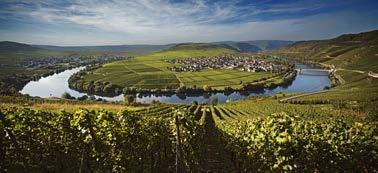

villages and renowned vineyard sites. The area south of Trier, or upper Mosel, takes in Bereich obermosel and Bereich Moseltor, which border Luxembourg. Bereich Saar and Bereich ruwer are named after their respective rivers.
Justifiably, Mosel vintners consider themselves to be riesling specialists. After all, more than half of the region’s vineyard area (5,000 ha/12,355 acres) is planted with this varietal. Growing conditions here are ideal for this late-ripening, noble white wine grape. The protected valleys make the region one of Germany’s warmest climatic zones. The steep slate slopes overlooking the rivers absorb the sun’s warmth during the day and release it at night. The roots of the vines penetrate deep into the earth in their search for water and minerals. These are the prerequisites that enable vintners to produce unique, elegant, fruity wines from their hand-picked grapes. wines with an enormous complexity of flavors and relatively low alcohol content – ideal for worry-free pleasure. The lusciously sweet dessert wines are also renowned the world over and fetch record prices at auctions every year. However, fans of drier wines will not be disappointed by what Mosel producers offer. There are excellent “feinherb” (off-dry) wines and harmoniously dry wines (not too astringent). These, too, are recognized with awards in national and international competitions.
Slate and riesling are the prevailing forces in the vineyards of the Mosel, Saar and ruwer. However, other varietals thrive here, too. Müller-Thurgau is the second most important white wine grape. The upper Mosel is home to the ancient white varietal elbling, possibly cultivated here more than 2,000 years ago. elbling grapes yield refreshing, fruity, uncomplicated, dry, still and sparkling wines. white Pinots, such as Grauburgunder (Pinot Gris) and weissburgunder (Pinot Blanc) as well
MOSEL – AT A GLANCE

Geographical location: Between the Hunsrück and eifel sections of the rhenish Slate Hills; the vineyard area follows the course of the Mosel river and its tributaries, Saar and ruwer · Climate: optimal warmth and precipitation in the steep slopes and valleys · Soils: Upper Mosel (bordering Luxembourg): shell-limestone and marl; in the valleys of the Saar and ruwer and Middle Mosel: devonian slate; south of Zell: soft, clayish slate and silica-rich graywacke; in valley sites: debris, gravel and sand deposits · Size: ca. 8,800 ha (22,000 acres) · Grape varieties: riesling, Müller-Thurgau, elbling
as Auxerrois and Chardonnay are increasingly cultivated. They thrive on chalky soils. red wines, too, are produced. Spätburgunder (Pinot Noir) and dornfelder have been cultivated here since the late 1980s.
The region is a highly attractive tourist destination and has a number of specially qualified guides to help visitors discover the region’s wine and natural highlights. Information: Moselwein e. V. Gartenfeldstraße 12a 54295 Trier Tel. +49 (0)651 710280 Fax +49 (0)651 45443 www.weinland-mosel.de info@weinland-mosel.de
Mosel: Landmarks of German Wine Culture
WEINGUT LUBENTIUSHOF IN NIEDERFELL, MOSEL
The slate terraces of the Lower Mosel are the perfect home to the vines of Weingut Lubentiushof of Niederfell. The extreme steepness of the slopes all but rules out the use of machines in the vineyards. Instead, everything is done by hand, and that requires time. For Andreas Barth, who holds a degree in law and came late to the world of wine, that's the way it should be. His attitude has made him into an expert for Riesling, done slow.
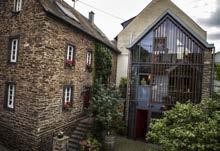
Riesling, Done Slow Lubentiushof dates back to a winery founded in 1711 and owned by the Princes von der Leyen. Andreas Barth and his wife Susanne took control of the estate in Niederfell on the Mosel river in 1994. realizing they didn't have enough space in the center of the village, they opted to expand their properties with a new building. And so was born their wine workshop on a tiny piece of property next to the historical winery building. The new construction is made of steel, glass, split stone and concrete, all designed to match the character of the village. Vertical wooden bars in front of the wrap-around glass facade serve as a curtain, providing some privacy. From the top floor, however, one can gaze across the Mosel to the Gondorfer Gänsberg. The renowned but steep “Gondorfer Gäns” site found there includes a portion of the estate's vineyards. True to his reputation, Andreas Barth likes to let nature set the pace. on weathered slate soils, some of his riesling vines were planted up to 100 years ago, and he gives the natural yeasts as much time as possible for fermentation.
Weingut Lubentiushof Niederfell/Mosel, Kehrstraße 16 Tel. +49 (0)2607 8135 www.lubentiushof.de
THE ROMAN WINE PRESS AT PIESPORT, MOSEL
Proof that the Romans once crushed grapes by foot can be found in an ancient wine press preserved in Piesport, near the Moselschleife (a major bow in the river). Piesport celebrates a Roman Wine Pressing Festival early each October, recreating the process used 1700 years ago, when slaves stomped the grapes with their bare feet. It's a time for men, women and children to don their loincloths and tunics and bring this historical press house back to life.
Salve, Piesport! with a screw press (including a suspended weight) now reconstructed to fit the historical press basket, the largest roman wine press north of the Alps is once again fully functional. The mechanism is 44 meters (144 ft) long and 20 meters (66 ft) wide, and was discovered in the 1980s at the foot of the famous “Piesporter Goldtröpfchen” hillside vineyard. It's estimated that back in the 4th century some 130 workers would process up to 60,000 liters of mash into 30,000 to 40,000 liters of wine each year. The vineyards belonging to the press house may well have stretched over 60 hectares (148 acres). The unusual size suggests that the Piesport wine press was once used for official purposes, such as in the service of the Prefecture of Trier or perhaps even the imperial court. regardless of the wine's eventual destination, it's clear that wine was produced in

grand style here – and that the roman presses on the Mosel validate the region's claim as one of the oldest winemaking hubs in Germany
Tourist-Information Piesport, Heinrich-Schmitt-Platz 1 Tel. +49 (0)6507 2027 www.piesport.de
WEINGUT DER VEREINIGTEN HOSPITIEN IN TRIER, MOSEL
The oldest wine cellar in Germany can be found in Trier – to be more specific, under the resplendent Baroque building in the park of the Vereinigten Hospitien (United Hospices). The building was erected in 1740 and serves today as a seniors and rest home. The cellar below, however, is a great deal older and dates back to 330. Emperor Constantine ordered that two giant storehouses be built here to hold grain and wine from the Roman estates along the Mosel.
Emperor Constantine's Wine Storehouse At 70 meters (230 ft) long and 20 meters (66 ft) across, the imperial storehouse was the largest non-residential roman building north of the Alps. one section of the original side walls has been retained to its full eight-meter (26 ft) height. Its upper section pokes through into the römersaal, an event room on the ground floor of the Baroque building. The lower section is now a full story deeper than in roman times and forms the wine cellar of the Vereinigte Hospitien. The Merovingian period saw the addition of heavy vaulted ceilings atop massive rounded pillars.
The charitable foundation itself dates back to another emperor: In 1804 Napoleon ordered the establishment of a hospital with 100 beds for wounded soldiers and another 50 beds for impoverished invalids. The city's infirmaries, which to that point had been maintained by the cloisters, were merged into the Vereinigte Hospitien in Saint Irminen, a former Benedictine abbey. The weingut der Vereinigten Hospitien estate was established to raise revenues for the institution, and even today contributes proceeds from its first-class rieslings from the Mosel and Saar Valleys.
Weingut der Vereinigten Hospitien Trier, Krahnenufer 19 Tel. +49 (0)651 9451210 www.weingut.vereinigtehospitien.de
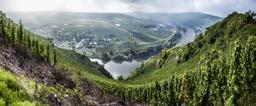
THE SONNENUHR VINEYARDS AROUND BERNKASTEL-KUES, MOSEL
The steep slopes of the Middle Mosel form the backdrop for a remarkable journey through time: In the middle of the vineyards, giant chalky-white surfaces with black numbers are spaced around the dark slate cliffs. It's possible to mark the time by following the pointer – presuming, of course, that the sun is actually shining. The sundials also mark the Sonnenuhren vineyards, considered some of the finest in the world, where sun-drenched vines produce world-class Rieslings.
Time Travel through the Vineyards Just a few kilometers west of Bernkastel-Kues, a sundial rises from the vineyards of the winegrowing town of Brauneberg. The sundial is visible from afar, can be adjusted for daylight savings and proclaims the name of the prestiguous “Juffer Sonnenuhr” for all to see. The blue-gray devonian slate is just one factor in a remarkable microclimate that has been measured at 41° C (106° F) in summer – very possibly a German record.
Further down the river, in the winegrowing community of wehlen, a giant sundial was built in 1842 on the slopes of the “Lammerterlay” vineyard; the idea became so popular that the site was soon renamed “wehlener Sonnenuhr” (wehlen Sundial). Germany's largest vineyard sundial was erected on the steep slopes of neighboring Zeltingen. And Germany's oldest sundial on the Mosel can be found on the ruins of a Medieval defense tower once part of the three knight's castles of Ürzig.
Mosel-Gäste-Zentrum Bernkastel-Kues, Gestade 6 Tel. +49 (0)6531 500190 www.bernkastel.de

The city's wine Queen, Anna the First from Tra100 years after that noteworthy visit, a bridge was erected over the Mosel between Trarbach and Traben – clearing the way for the first road between Bernkastel and Koblenz. In 1904, the two communities merged and the newly proclaimed twin towns of Traben-Trarbach suddenly became the second largest wine shipment site
ben-Trarbach, explains that wine cultivation and production were important factors alongside trade. The vineyards high above the Moselschleife, a notable hairpin bow in the river, are in spots so steep that they can only be worked by hand or using a special monorack train. The clay shale soils are particularly hospitable to riesling vines, producing lively wines of
TRABEN-TRARBACH, MOSEL
It was a dark and stormy November night in 1792 when the waves of the Mosel pitched the small boat carrying Goethe to the town of Trarbach. The famous German poet and statesman, it was rumored, could only relax when he was poured a glass “of the most sublime Mosel wine.” Perhaps a second followed. And perhaps the next morning he gazed out over the stunning valley and the picturesque ruins of the Grebenburg, with a fantastic view still enjoyed by visitors today.
High above the Moselschleife concentrated elegance.
in europe after Bordeaux. Tourist-Information Traben-Trarbach, Am Bahnhof 5 Tel. +49 (0)6541 83980 www.traben-trarbach.de
THE BREMMER CALMONT, MOSEL
An autumn visit to the steepest vineyard in Europe, the Bremmer Calmont, is an intoxicating experience, long before the first glass has even been poured. The vines' bright colors, ranging from rich greens and sunny yellows to warm oranges and fiery reds, are a feast for the senses. They illuminate the breathtaking landscape of the Moselschleife, the ruins of Stuben Monastery on its peninsula and the steep river cliffs of the Calmont ridge. And now it's time for a glass of Riesling – what better way to take it all in...
A Whirl of Colors on the Warm Slopes The vintners themselves know that working these unique parcels requires extreme effort – even with the monorack train, built in the 90s to finally bring a bit of technological progress to the rugged steep slopes. The vineyards on the Bremmer Calmont are counted among the steepest classified single sites found anywhere in the world. The sun shines almost horizontally here to the ground, with the slate in the soil capturing
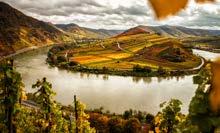
the warmth and returning it to the vines. This may explain the site's name: 'Calmont' likely derives from the roman term “calidus mons,” meaning “warm mountain.”
The winegrowing tradition here can trace its written origins back to late antiquity. In 558, roman poet Venantius Fortunatus recorded his thoughts on the vineyards at Calmont: “In all directions you see the heights clad with leafy vines, [...] the wood planted in thick rows in the slate soil. […] where tendril-filled vineyards reach up to bare mountain peaks, and the full canopies cast shadows over the dry scree: Here the vintner gathers the ripe grapes, hangs from the cliff, harvests the fruit.”
Tourist-Information Bremm an der Mosel Tel. +49 (0)175 3249114 www.bremmer-calmont.de










